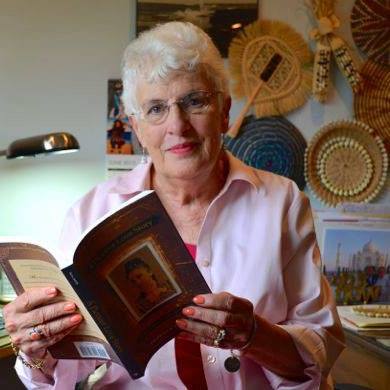Orange and white breast feathers shimmer in the morning sun. From a perch in the oak tree an elegant bird gazes at the tangle of bushes and tree limbs below. A male Cooper’s hawk tosses his head as if to say, “This is a good neighborhood.”
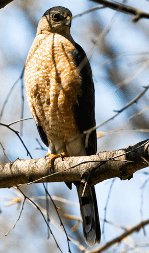
Bluish-gray feathers cloak his back. Darker feathers covering the top of his head resemble a French beret. Sharp talons grip the oak tree’s bark. A Cooper’s hawk is seen standing motionless on the corner of the wooden fence. These are not the glowing red eyes seen several days earlier. These yellow eyes shining like traffic lights signaling, “caution” belong to a female Cooper’s hawk. Her long tail feathers with bands of brown and grayish cream with a bold white tip drape over the edge of the fence like goods in a store display.
How to tell who is Papa and who is Mama? They both have short, rounded wings. Their long tails are colored with dark and light brown bands ending with a broad distinctive white tip. Their size and the color of their eyes help distinguish them. Papa is smaller than Mama by one-third. Her glowing yellow eyes indicate she is still young.
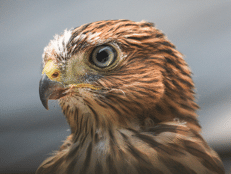
These new neighbors chose a street with many trees and suburban homes. A variety of small birds frequent this neighborhood hunting for crabapples, seeds on trees as well as worms and bugs of all sizes and shapes. Red tail hawks soaring overhead are often spotted on the hunt for these small birds. But Cooper’s hawks are rarely seen because of their secretive and swift hunting habits. Soaring through the leafy umbrella of limbs and leaves keep them hidden. A sudden dive for prey may bring them briefly into view.
Birdfeeders usually attract many species of birds. But the regular bird visitors have looked around and seen these hawks on the hunt. The small birds fly away. The juncos, ready to signal the end of winter, hasten their flight north to escape the hunting hawks. Cardinals become scarce. Doves, sparrows and robins hide. The red belly woodpecker is now a rare sight. Even chipmunks scurry into the garden wall.
Before the leaves burst forth on the trees, Mama Cooper’s Hawk is ready for nest building. Of all the many oak, maple, locust, crabapple and sweet gum trees in the neighborhood, she chooses a large old oak tree in a neighbor’s yard across the street. The nest she and Papa Cooper’s now build rests against the main trunk of the tree. The two horizontal branches 40 to 50 feet above the ground give strong support. Their platform nest of sticks and twigs spans about 30 inches across, big enough to hold growing babies.
Both Mama and Papa fly back and forth across many yards carrying twigs and sticks. High in the old oak tree among the unfurling leaves, the bulky platform of twigs takes shape. As the oak leaves mature, the leafy crown of the tree begins to hide the nest. It finally disappears from sight at street level as the large, majestic tree unfurls its leaves.
Papa helps feed Mama for up to a month before she lays her eggs. As Papa brings food to Mama, this “blue darter” swoops through the yard yelling his harsh “cak – cak” to let all know that this is his territory.
Before babies are visible, Papa continues to fly back and forth hunting food for his family. Identified by his smaller size and darker color, he fulfills his papa role for nearly a month. Mama lays and incubates (sits on the eggs to provide heat, to promote the development and hatching of the young) three eggs that hatch in about five weeks. Laying one egg every other day ensures different demands from each baby as they grow. Mostly Mama does incubation, for a little over a month. During this time, Papa continues to bring food to her. Sometimes he helps by giving Mama a brief rest. He sits on the nest to do the incubating while she finishes her meal.
By early June, a bit of searching reveals the one spot where the nest is visible for human neighbors standing in a driveway. Now that oak leaves hide much of the tops of the trees, there is only one spot with a clear view of the substantial nest of sticks. With the nest located, the human watchers move into high gear. A Canon camera and a Swarovski spotting scope are set up on tripods to watch and photograph the journey of three young hawks. The camera gear is lugged across the street every few hours to capture the action. Diligence is required if the expected baby activity is to be captured. Days are spent watching through the spotting scope and shooting pictures every time the babies lift their heads.
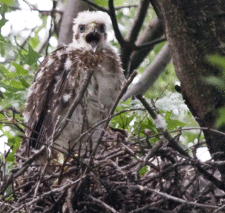
When the babies are about three weeks they gradually lose the fluffy white down that looks so cuddly. Their mixed brown and white streaked appearance starts to emerge. Two tiny hawks stare out over the edge of the nest. Later a third becomes visible. Grayish baby blue eyes gaze out into the unknown. The hatchling’s eyes opened at birth, and they held their heads up immediately. For the first two weeks after they hatch Mama covers the chicks with her wings to give warmth and body contact.
The older nestling’s bibs of brown and white feathers with thick noodle-like streaking look as disorganized as a four-year-old’s coloring job. By the time the three funny-looking babies stare out at their world, pinfeathers are developing and continue to grow during their infancy.
Mama swoops into the nest bringing breakfast. She spits small chunks of meat out for each of her young. After depositing the food, she surveys the area. She is constantly checking on the safety of her children.
By three weeks old, brown feathers on tails and scapulars (shoulder blades) appear. These strong, but lightweight feathers protect the hawks from both sun and rain. Slowly they grow into the dress of grown-ups. But chests and tops of heads are still covered with baby white down. Their pale blue eyes seem too big for their small heads. Flight feathers develop on the oldest baby first. Soon, one and then another begins stretching their wings.
Since these babies have hatched every other day, it soon becomes obvious that three different sizes and abilities are developing in the nest. The oldest juvenile moves to the left edge of the nest first. His confidence builds as he moves around. Mama’s golden eye watches him. The middle juvenile rises and looks out past his brother. The youngest is huddling down in the nest.
As the young hawks develop, the flapping of wings is soon combined with short hops outside the nest. The first-born graduates first from being an older “nestling” to being a “brancher” as he moves outside the nest. An hour later, his sibling is sitting in the nest with two long yellow feet sticking up in the air like baby feet sticking out of a stroller. He is whistling “kleer” which sounds like a dog’s squeaky chew toy.
Mama, communicating in whatever way hawks communicate, encourages her young to keep experimenting with their wings. She often stands on a branch near the nest urging repeated exercising. Daily they demonstrate increasing bravery.
The flapping and hopping continue until one day, the oldest juvenile flies straight up to a branch above the nest. The effort of actually leaving the nest area is exhausting, so raising one leg to a resting position helps. The next order of business is a short nap.
The youngest remains huddled in the nest while his brother is learning to flap his wings. He stands in the center of the nest and gazes out across the suburban yard as if to ask, “What is out there to explore?”
A few minutes later, with new courage, the youngest lifts his wings with a big flap. He glances up and sees his brother farther out on another branch above the nest. They are relieved to see that Mama is on a nearby branch, always present with her alert yellow eyes watching for any trouble.
By now the two youngest hawks think of risking the move into the big spaces beyond the nest. They look up toward their adventurous brother and venture to the edge of the nest. Flapping and flapping, one of them hops out on to the branch. He looks older every day as he puffs up his chest with its brown vertical stripes down his front and the light tan bib high on his chest with a white background across his belly. The adventurous one recognizes the hesitation of his siblings as he returns to the nest. He reassures them that flying is safe and they are big enough to try.
Mama decides they are all safe and takes time out from her daily mothering chores for a brief rest. She flies off to a nearby birdbath which is spouting water from an iron lion-head. She soaks every feather with a lot of splashing and flapping of her wings, but her feathery back sheds water like a brand-new raincoat.
By late June, all three of the young hawks have flown to a large oak in another yard. One tries out a branch in a crabapple tree. He needs a ten-minute rest after the long flight across the street. Then suddenly he goes on the alert as he sees a running chipmunk below. His instincts send him flying down for the chase. Since Mama hasn’t taught catching yet, he misses the chipmunk.
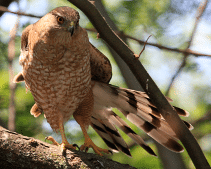
Mama, standing in a stern pose on a branch near her students, assumes her role of teacher. She calls them to their studies. Her choice for the classroom this time is a cluster of large oak, locust and crabapple trees near a human’s window. A section of the yard where ivy, viburnum bushes, locust trees and thickets of this and that grow wild is a perfect schoolroom. This wild corner provides cover for small birds and other critters that this young family will need.
Mama spends several weeks in serious “hawk training.” She knows she must instill some discipline into her three students if they are to learn how to be successful hawks. She never gives up. She continually calls them back together to show them the things they must know. She conveys flight and hunting skills by dropping food to them while in flight and flushes out birds for them to hunt.
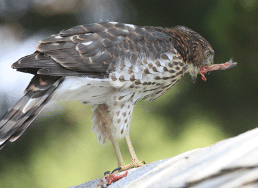
The largest (oldest) of the three stands on the peak of the garage roof with a small bird carcass. Is this his catch or has Mama brought this to him so he can practice tearing food apart? Still not sure what to do with this mess at his feet he puts his lessons into practice. Using his sharp bill, he tears the meat into pieces as he has seen Mama do.
He pulls off a long piece of meat. What can he do with this now? How can he swallow it? He studies his dilemma for several minutes and finally, swallows a bit at a time … Ah! finally he succeeds in getting it down.
One of the young hawks is irritated with an itch under his bill. He quits paying attention to Mama’s teaching and takes time out. Raising his long yellow leg, he gives himself a good scratch with his sharp talons. Ah! That feels better.
The young hawks frequently tire during skills training and experience the need for a nap. One by one they collapse their body on a branch when exhaustion takes over. They discover that oak and locust branches both serve as comfy “kindergarten nap rugs.” Overcome by weariness, they doze for a few minutes. Head’s droop, eyes flicker closed as a head touches the branch.
Mama only allows a couple of minutes of rest. She again calls her class back to attention from her position on a locust branch. One juvenile complains of so much work and lies back down to rest. Mama taps her foot in exasperation swishing her tail feathers back and forth.
Finally, the three juvenile hawks squirm on a nearby branch like a typical kindergarten class before settling down to learn. One successfully passes one of his tests. He has a bird carcass in his talons.
By late afternoon, two of the young hawks stand on the locust tree trunk in triple alert. They gaze up, down, and across looking for a bird or chipmunk. They are striving to prove to Mama they have learned their lessons.
Suddenly one takes off in swift flight after a chipmunk. He misses the chipmunk but consoles himself in the birdbath. He cools his feet and enjoys a drink of water. An hour later two of the young hawks regroup on the corner of the garage roof. Attempts to catch food have been unsuccessful. They stand still, wondering what to do next. They look forlorn with empty talons.
Mama, tired from teaching all day, takes a break. She leaves the classroom and lands on a wood fence at the other end of the yard. This fence makes a perfect snack room as she enjoys a few bites of the catch she has in her talons.
By July, the three young Cooper’s hawks exhibit learned bravery and skills. The hawks spend most of their time and energy exploring beyond their immediate classroom. Even after they leave the nest, the young continue to return to the nest at night. Mama knows she needs to provide food for at least another five to six weeks.
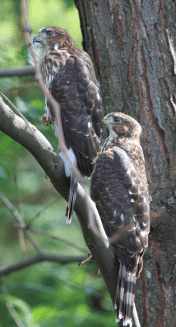
During this time, the young hawks gradually learn to hunt on their own. Mama continues to stay close by to ensure their safety. At the back of the yard she finds a low stonewall that is a pleasant place for her to stand to watch their exploring antics.
Distracted from her vigilance, Mama spins around to look deep into the ivy for scurrying chipmunks. She knows if she puts her head deep into the greenery one of them will surely make a mistake. Spreading her wings to shade the area helps her look for a critter. Awe! What does she hear hidden in the wall?
Mama flies back into the oak tree with her tasty chipmunk catch. It is time for another lesson on what to do with a catch.
The young birds’ hunting prowess continues to develop. One of the youngsters flies down on an unsuspecting bird in the middle of the lawn. This success provides him with another opportunity to practice pulling meat from his prize like Mama taught him to do. The young hawks like to stand proud and tall as their success in hunting increases. Curiosity leads one of them to pause and look through a bedroom window at the strange human creatures. It is all part of the exploration beyond the classroom trees.
One young hawk develops an itch under his wing feathers. He decides to attack the itch with his sharp hooked bill.
The hawk playground expands; all other birds keep out of sight as much as possible. One by one the juvenile hawks discover fun and new places to perch and to explore. A strange metal bench becomes a “sit and rest” spot for one. His brother tests the end of a rope hammock by standing on the end of the metal frame.
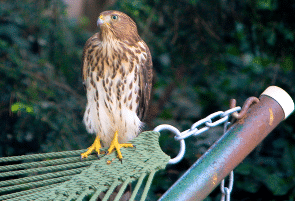
The third hawk enjoys a quick fluttery bath in a flat circular birdbath. He has found a perfect spot on a hot July day to drink the cool liquid. He welcomes this water like a child’s welcome of cotton candy at the carnival.
After his drink he finds something wrong with one of his talons. He carefully lifts his toes and cleans them. Then he takes off for his favorite tree limb with a flurry and a swoosh of wing feathers.
